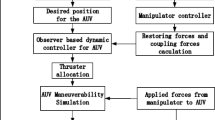Abstract
The manipulation in singular regions generates an instantaneous reduction in the mechanism mobility which can result in some disturbances in the trajectory tracking. In proximity of the singularities, small velocities in the end-effectors generates high speeds in the joints due to the gradual reduction of the mobility. The phenomenon of kinematic singularity generates a instantaneous instability in torque profile of the redundant robotic systems by the transformation of secondary joints to primary joints. The disturbances of the underwater environment intensifies the effects of the kinematic singularities because the hydrodynamic strongly oppose to torque variations. This work presents a methodology for using dual quaternions in the posture feedback of a Underwater Vehicle-Manipulator System (UVMS) using the Davies method which avoids kinematic singularities and ensures the optimal torque profiles.
Similar content being viewed by others
References
Soylu S., Buckham B. J., Podhorodeski R. P.: Redundancy resolution for underwater mobile manipulators. Ocean Engineering 37, 325–343 (2010)
From P. J., Duindam V., Pettersen K. Y., Gravdahl J. T., Sastry S.: Singularity-free dynamic equations of vehicle-manipulator systems. Simulation Modelling Practice and Theory 18, 712–731 (2010)
Nagi F., Ahmed S.K., Abidin A.A. Z., Nordin F.H.: Fuzzy bang-bang relay controller for satellite attitude control system. Fuzzy Sets and Systems 161, 2104–2125 (2010)
ErdongJ. Zhaowei S.: Passivity-based control for a flexible spacecraft in the presence of disturbances. International Journal of Non-Linear Mechanics 45, 348–356 (2010)
Xu W., Li C., Wang, Liu Y., Liang B., Xu Y.: Study on non-holonomic cartesian path planning of a free-floating space robotic system. Advanced Robotics 23, 113–143 (2009)
Sahu S., Biswal B.B., Subudhi B.: A novel method for representing robot kinematics using quaternion theory. IEEE Sponsored Conference on Computational Intelligence, Control And Computer Vision In Robotics & Automation 03, 10–17 (2008)
Qiao S., Liao Q., Wei S., Su H.: Inverse kinematic analysis of the general 6r serial manipulators based on double quaternions. Mechanism and Machine Theory 45, 193–199 (2010)
Santos C.H.F., Guenther R., Martins D., De Pieri E.R.: Virtual kinematic chains to solve the underwater vehicle-manipulator systems redundancy. Journal of the Brazilian Society of Mechanical Sciences and Engineering 28, 354–361 (2006)
Johnson S.M., Williams J.R., Cook B.K.: On the application of quaternionbased approaches in discrete element methods. Engineering Computations: Internation Journal for Computer-Aided Engineering 26, 610–620 (2009)
Zamora-Esquivel J., Bayro-Corrochano E.: Robot perception and handling actions using the conformal geometric algebra framework. Advances in Applied Clifford Algebras 20, 959–990 (2010)
Hildenbrand D., Zamora J., Bayro-Corrochano E.: Inverse kinematics computation in computer graphics and robotics using conformal geometric algebra. Advances in Applied Clifford Algebras 18, 698–713 (2008)
Campos A., Guenther R., Martins D.: Differential kinematics of serial manipulators using virtual chains. Journal of the Brazilian Society of Mechanical Sciences and Engineering 27, 345–356 (2005)
B. Siciliano, L. Sciavicco, L. Villani, and G. Oriolo. Robotics: modelling, planning and control. Springer Verlag, 2008.
Simas H., Guenther R., da Cruz DFM, Martins D.: A new method to solve robot inverse kinematics using assur virtual chains. Robotica Cambridge Univ Press 27, 1017–1026 (2009)
Chyba M., Haberkorn T., Singh S.B., Smith R.N., Choi S.K.: Increasing underwater vehicle autonomy by reducing energy consumption. Ocean Engineering 36, 62–73 (2009)
Dunbabin M., Corke P., Vasilescu I., Rus D.: Experiments with cooperative control of underwater robots. The International Journal of Robotics Research 28, 815–833 (2009)
Selig J.M.: Clifford algebra of points, lines and planes. Robotica, Cambridge Univ Press 18, 545–556 (2001)
L.W. Tsai. Robot Analysis: The Mechanics of Serial and Parallel Manipulators. Wiley-Interscience, 1999.
Author information
Authors and Affiliations
Corresponding author
Rights and permissions
About this article
Cite this article
Oliveira, A., De Pieri, E. & Moreno, U. Optimal Trajectory Tracking of Underwater Vehicle-Manipulator Systems Through the Clifford Algebras and of the Davies Method. Adv. Appl. Clifford Algebras 23, 453–467 (2013). https://doi.org/10.1007/s00006-013-0380-x
Received:
Revised:
Accepted:
Published:
Issue Date:
DOI: https://doi.org/10.1007/s00006-013-0380-x




